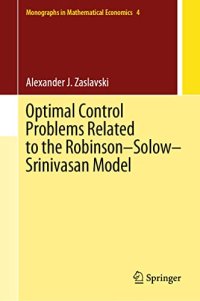
Ebook: Optimal Control Problems Related to the Robinson–Solow–Srinivasan Model
Author: Alexander J. Zaslavski
- Genre: Economy // Mathematical Economics
- Series: Monographs in Mathematical Economics 4
- Year: 2021
- Publisher: Springer
- City: Singapore
- Language: English
- pdf
This book is devoted to the study of classes of optimal control problems arising in economic growth theory, related to the Robinson–Solow–Srinivasan (RSS) model. The model was introduced in the 1960s by economists Joan Robinson, Robert Solow, and Thirukodikaval Nilakanta Srinivasan and was further studied by Robinson, Nobuo Okishio, and Joseph Stiglitz. Since then, the study of the RSS model has become an important element of economic dynamics. In this book, two large general classes of optimal control problems, both of them containing the RSS model as a particular case, are presented for study. For these two classes, a turnpike theory is developed and the existence of solutions to the corresponding infinite horizon optimal control problems is established.
The book contains 9 chapters. Chapter 1 discusses turnpike properties for some optimal control problems that are known in the literature, including problems corresponding to the RSS model. The first class of optimal control problems is studied in Chaps. 2–6. In Chap. 2, infinite horizon optimal control problems with nonautonomous optimality criteria are considered. The utility functions, which determine the optimality criterion, are nonconcave. This class of models contains the RSS model as a particular case. The stability of the turnpike phenomenon of the one-dimensional nonautonomous concave RSS model is analyzed in Chap. 3. The following chapter takes up the study of a class of autonomous nonconcave optimal control problems, a subclass of problems considered in Chap. 2. The equivalence of the turnpike property and the asymptotic turnpike property, as well as the stability of the turnpike phenomenon, is established. Turnpike conditions and the stability of the turnpike phenomenon for nonautonomous problems are examined in Chap. 5, with Chap. 6 devoted to the study of the turnpike properties for the one-dimensional nonautonomous nonconcave RSS model. The utility functions, which determine the optimality criterion, are nonconcave. The class of RSS models is identified with a complete metric space of utility functions. Using the Baire category approach, the turnpike phenomenon is shown to hold for most of the models. Chapter 7 begins the study of the second large class of autonomous optimal control problems, and turnpike conditions are established. The stability of the turnpike phenomenon for this class of problems is investigated further in Chaps. 8 and 9.
The book contains 9 chapters. Chapter 1 discusses turnpike properties for some optimal control problems that are known in the literature, including problems corresponding to the RSS model. The first class of optimal control problems is studied in Chaps. 2–6. In Chap. 2, infinite horizon optimal control problems with nonautonomous optimality criteria are considered. The utility functions, which determine the optimality criterion, are nonconcave. This class of models contains the RSS model as a particular case. The stability of the turnpike phenomenon of the one-dimensional nonautonomous concave RSS model is analyzed in Chap. 3. The following chapter takes up the study of a class of autonomous nonconcave optimal control problems, a subclass of problems considered in Chap. 2. The equivalence of the turnpike property and the asymptotic turnpike property, as well as the stability of the turnpike phenomenon, is established. Turnpike conditions and the stability of the turnpike phenomenon for nonautonomous problems are examined in Chap. 5, with Chap. 6 devoted to the study of the turnpike properties for the one-dimensional nonautonomous nonconcave RSS model. The utility functions, which determine the optimality criterion, are nonconcave. The class of RSS models is identified with a complete metric space of utility functions. Using the Baire category approach, the turnpike phenomenon is shown to hold for most of the models. Chapter 7 begins the study of the second large class of autonomous optimal control problems, and turnpike conditions are established. The stability of the turnpike phenomenon for this class of problems is investigated further in Chaps. 8 and 9.
Download the book Optimal Control Problems Related to the Robinson–Solow–Srinivasan Model for free or read online
Continue reading on any device:

Last viewed books
Related books
{related-news}
Comments (0)